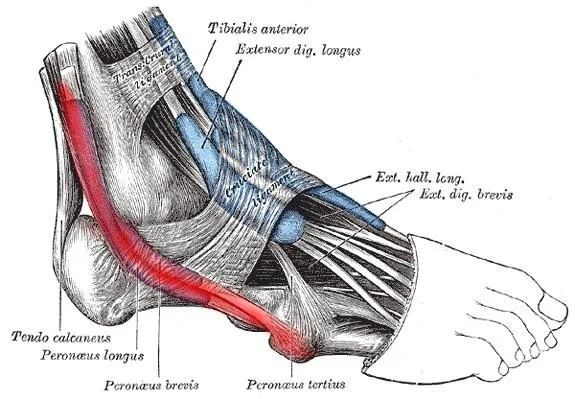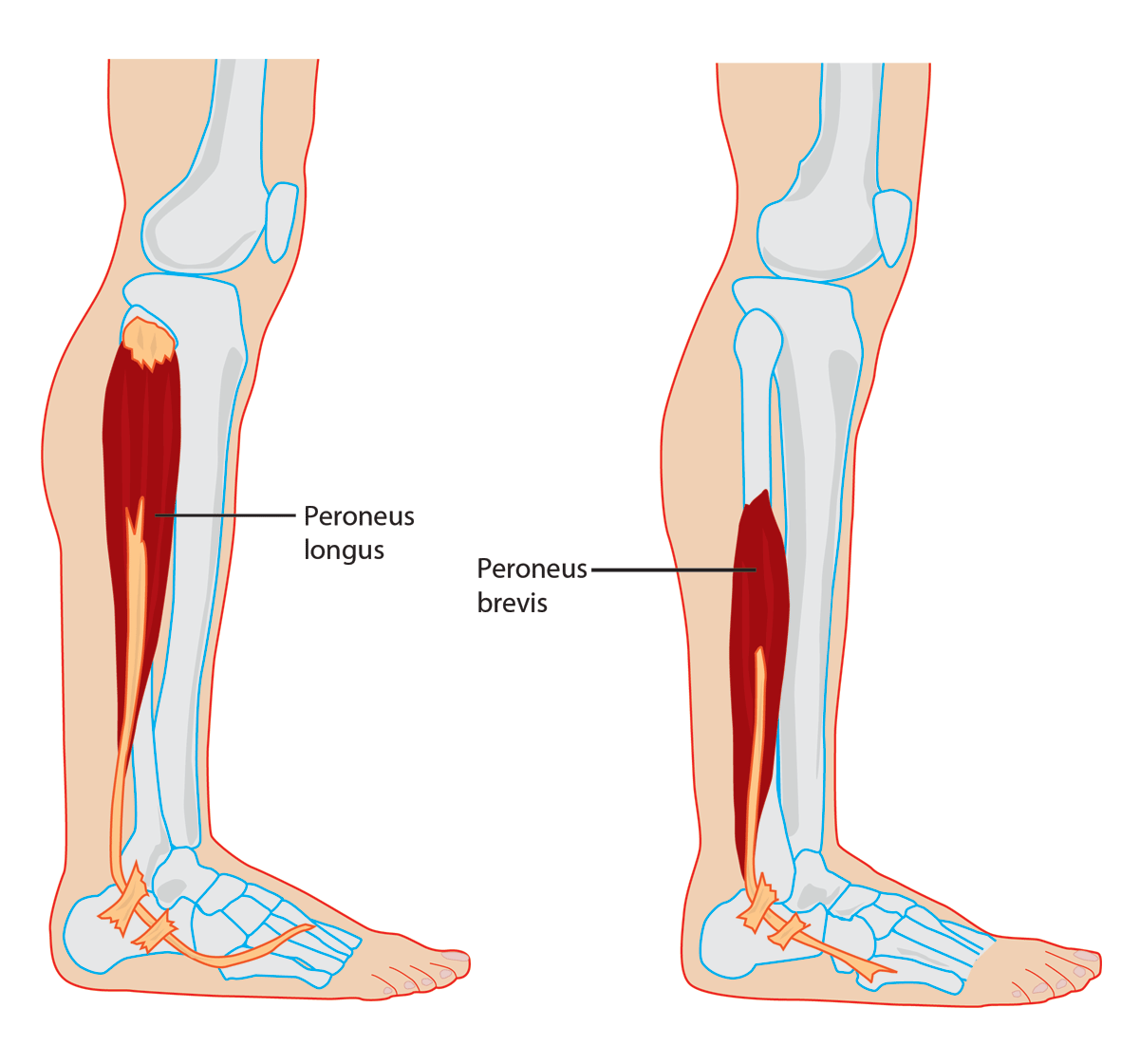Peroneal Tendonitis And The Best Stretches To Relieve Pain
So you’ve visited your doctor to deal with that nagging pain on the outside of your foot or leg. They’ve told you that you may be suffering from peroneal tendonitis. Okay great but what does that mean? How do we treat it? How long will it take to go away? Our expert physiotherapists are here to help and provide some insight on how to manage this pain so you can get back to all the activities you love.
What is peroneal tendonitis?
To understand peroneal tendonitis, we need to first understand what tendonitis is. Tendonitis refers to the inflammation of tendons (a prefix of -itis usually refers to inflammation). Peroneal tendonitis gets its name from the structures it affects. People tend to ask what the difference is between tendons and ligaments. Simply put, tendons connect muscle(s) to bone(s), while ligaments connect bone to bone. That means Peroneal tendonitis is an inflammation of the tendons of the muscles found on the outside of your lower leg. Lets cover what those muscles are exactly.
What are the Peroneal/Fibularis Muscles?
The peroneal muscles are a group of muscles that are found on the outside aspect of your leg. The two muscles that make up the peroneal muscles are called the peroneus longus and the peroneus brevis. These muscles travel from the outside of your lower leg and run just below your ankle before attaching into the bones of your feet. The Peroneal muscles refer to the same group of muscles which are also referred to as the fibularis longus and brevis muscles.
Causes of Peroneal Tendonitis
Peroneal tendonitis is more common in individuals who are:
more active
perform repetitive ankle motions resulting in overuse of the tendons
have higher arches of the foot
run on uneven surfaces
have poor circulation
increase their physical activity too suddenly and/or with incorrect movement patterns
What are the Symptoms of Peroneal Tendonitis?
Peroneal tendonitis usually presents its symptoms in the form of:
swelling or edema in the lower lateral side (outside) of the leg
irritation, discomfort, or pain on the outside of the lower leg above the ankle
outer foot pain or pain on the side of the foot
changes in temperature, i.e. warm to the touch
Limping
Pain while performing exercises that require a sudden change in direction
How is Peroneal Tendonitis Diagnosed?
In order to come to a diagnosis your healthcare practitioner will conduct:
a medical history; which includes any relevant previous surgeries, injuries, and or health conditions
general health questions
level of activity
regular sport and hobbies
recording notable symptoms
gait assessment
range of motion assessment
strength assessment
joint assessment
palpation
Always consult a qualified health practitioner (i.e. Physiotherapist or Sports Doctor) for proper diagnosis and management of an injury. With a quick and accurate diagnosis you will reduce your risk of having the condition become more severe and/or chronic. It may also accelerate your recovery.
If the pain doesn’t improve with rest, always seek medical care, as this could be more serious and, in some cases, require surgery.
How long will it take to heal?
If you take action and are diagnosed right away your chances of recovering quicker are much higher. Usually if upon onset of symptoms you see your healthcare provider and begin therapy, it should take anywhere from 2-4 weeks to recover from this injury. If your pain does not subside and is present for longer than three months and is now chronic it is referred to as peroneal tendinosis (tendonitis turns to tendonosis when it becomes a long standing problem). In severe cases surgery may be required. Thus it is always important to make sure you act on this and get care right away.
How to treat peroneal tendonitis:
Medication: Anti-inflammatory medication can help decrease swelling and increase the rate of recovery. It is very important to make sure that you consult your doctor before taking any sort of medication.
Immobilization: By decreasing movement of the affected area it will decrease tension on the tendons and allow them to heal faster.
Rest from aggravating activities: As this injury may be caused by repetitive movements, abstaining from these activities will allow the tendons to rest and heal.
Physical therapy: Perhaps the most important aspect of treatment will be ensuring that you have a comprehensive treatment plan in place. This will not only allow you to feel better much sooner, but it will also give you exercises to help prevent the injury from becoming recurring.
Orthotics: Orthotic inserts have had positive in some patients that are diagnosed with peroneal tendonitis. These medical devices help give additional support to your feet and in turn help decrease tension on the peroneal tendons.
Best Stretches To Manage and Heal Peroneal Tendonitis
Below are the top 3 stretches and exercises recommended by our Senior Physiotherapist, to manage this condition at home. As always, we recommend speaking to a healthcare professional first and if the stretches seem too painful, stop immediately.
1) Calf Stretches
This is a common stretch which can be done many different ways. One way is to assume a lunge position with the leg to be stretched behind you with your knee straight. The stretch should be felt at the back of your lower leg. Follow the steps below to ensure you are doing this correctly.
i) Take a step back with the leg you are to stretch. You may place your hands on a wall for support
ii) Bend the forwards leg as you keep the back leg straight
iii) In this lunge position, try to keep the heel of your back foot on the ground
iv) Hold this stretch for 60 seconds for 3 sets
v) Perform this stretch 3 times per day
2) Hamstring Stretches:
It is important to stretch the muscles above and below the affected area. Stretching larger muscle groups have a beneficial effect on decreasing neural tension and fascial tightness. Fascia is a layer of connective tissue which holds groups of muscles together.
i) Find a large bath towel
ii) Loop the towel around your toes of the leg you are stretching
iii) Lie down and lift the stretching leg while pulling on the towel
iv) Your opposite leg should lie flat and the leg being stretched should be straight
v) Hold this stretch for 30 seconds for 3 sets
vi) Perform daily
3) Golf Ball massage:
To do this activity you will need a golf ball, or any hard round object. This technique requires you to apply firm pressure underneath the sole of the foot in order to release tight tissues in this area. The purpose of this is to help release the intrinsic muscles of the foot as well as the plantar fascia.
i) Sit straight with your feet flat on the floor
ii) Place the golf underneath the arch of your foot
iii) Apply firm pressure by putting weight through your foot into the golf ball
iv) Gently roll the ball forwards and back on the sole of the foot while maintaining firm pressure
v) Do this for 1-2 minutes as tolerated
vi) Do this 3x/day
Do I need surgery for Peroneal Tendonitis?
Although the majority of cases of peroneal tendonitis will resolve with physical therapy, some patients may need to undergo surgery for this condition. These cases are usually those who have had it for a longer period of time, thus highlighting the importance of early diagnosis and treatment.
Should I be wearing a boot or brace?
It has been shown that a “Cam walker boot” and/or an ankle brace can help support immobilization and restrict certain aggravating movements. CAM stands for Controlled Ankle Motion, and does exactly that. Typically the boot controls unwanted movemenet while allowing movement that is helpful for healing. Ankle braces will attempt limit movement in all direction preventing pushing into strenous ranges of motion. However, it is very important to always consult a healthcare provider before wearing a boot or a brace.
Conclusion
All in all peroneal tendonitis is a common and treatable condition. Getting the correct diagnosis is important, followed by appropriate management and stretches at home. By taking the appropriate steps and beginning treatment early you should be able to return to activities within as little as 2 weeks.
If you’re unsure of what to do, an expert opinion is always the best option. Our physiotherapists are available to thoroughly investigate this condition, the cause, and what best you can do to get back on the right track!
















